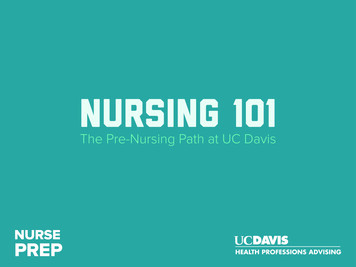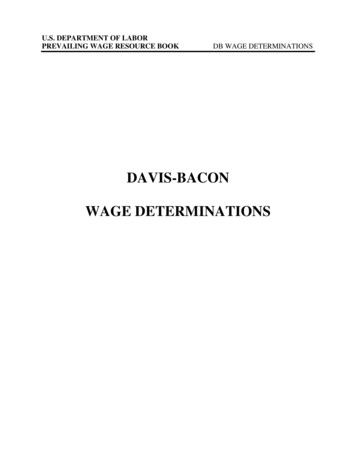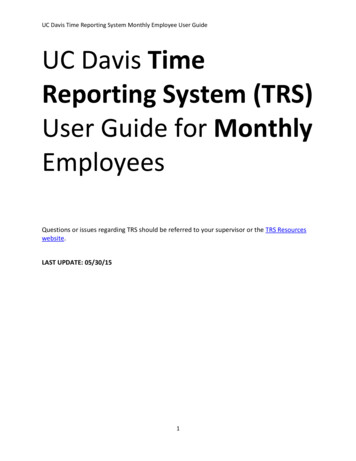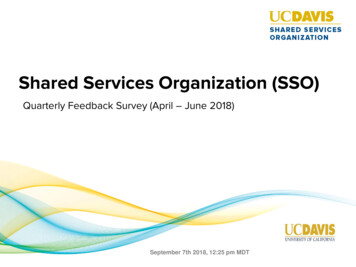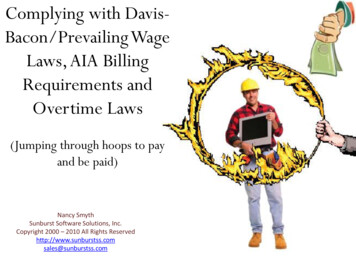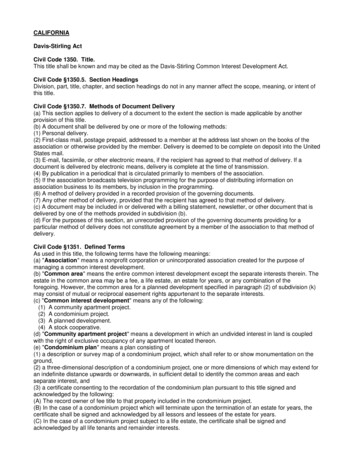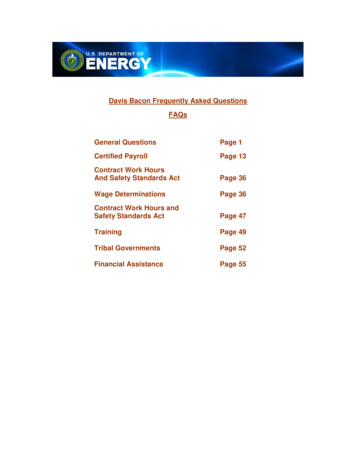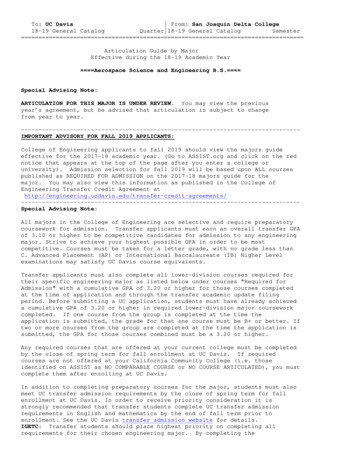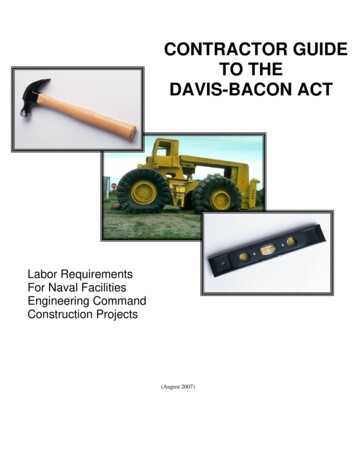
Transcription
CONTRACTOR GUIDETO THEDAVIS-BACON ACTLabor RequirementsFor Naval FacilitiesEngineering CommandConstruction Projects(August 2007)NAVFAC
INTRODUCTIONSECNAVINST 4200.36A assigns to the Naval Facilities EngineeringCommand the responsibility for preparing and maintainingcontractor industrial relations policy and procedures oncontracts with construction requirements. This document providescompliance guidance to Naval Facilities Engineering Commandcontractors on various labor requirements, emphasis on theDavis-Bacon Act. It supports the Department of the Navy policythat proper and consistent implementation of labor standards inDepartment of the Navy contracts promote good business andeffective contracting in terms of price, quality, speed ofdelivery, customer satisfaction and mission success.The guidance provided in this document does not substitute forfull and careful review of the contract and all applicablestatutes and regulations, such as the Federal AcquisitionRegulation and its Supplements and the Department of Laborregulations related to these issues. If there is any conflictbetween those requirements and this publication, the statutesand regulations applicable at the time of contract award willapply.There are three chapters in this Guide.The first chapterprovides a brief overview of the statutes and regulationspertaining to Federal labor standards on construction contracts.The second chapter provides guidance on the contractor’sresponsibilities with regard to compliance with labor standardsand payroll reporting requirements. The third chapter discussesprocedures for compliance issues that are not resolved withcontracting agency administration and enforcement.Questions pertaining to a solicitation or contract should bedirected to the contacting officer.Questions about the content of this Guide should be directed tothe NAVFAC Labor Advisor at NAVFACLaborAdvisor@navy.mil.1
TABLE OF CONTENTSPage1INTRODUCTIONTABLE OF CONTENTSCHAPTER 1.2LAWS, REGULATIONS, CONTRACTS AND RESPONSIBILITIES1-1Davis-Bacon Act and other Labor Lawsa. Davis-Bacon Actb. Contract Work Hours and Safety Standards Actc. Copeland Actd. Fair Labor Standards Act555551-2Davis-Bacon Act Regulations51-3Construction Contract Provisionsa. Labor Standards Clausesb. Davis-Bacon Act Wage Determinations6661-4Responsibility of the Prime Contractor61-5Responsibility of the Contracting Officer7CHAPTER 2. COMPLYING WITH LABOR STANDARDS AND PAYROLL REPORTINGREQUIREMENTSSection I – Definitions and Requirements2-1Davis-Bacon Act Definitionsa. Laborer or Mechanicb. Apprenticesc. Site of work88882-2Wage Determination/Postingsa. The Work Classifications and Ratesb. Postingsc. EEO Requirements99992-3Basic Compliance Requirementsa. Basic wage/benefit requirementb. Apprentice Ratesc. Prevailing Wages or Wage Ratesd. Fringe Benefitse. Site of Workf. Overtimeg. Deductionsh. Classification of Workers1010111112121212Additional Job Classifications and Ratesa. Additional Classification Rulesb. Making the Request1313132-42
c.d.e.2-5Employees’ ReviewNAVFAC ReviewDOL DecisionCertified Payroll Reportsa. Payroll Formatsb. Payroll Certificationsc. “No Work” Payrollsd. Payroll Review and Submissione. Payroll Retentionf. Payroll Inspection14141414141515151616Section II -- Reporting Requirements2-6Completing a Payroll Reporta. Project and Contractor or Subcontractor Informationb. Employee Informationc. Work Classificationd. Hours Workede. Rate of Payf. Pieceworkg. Gross Wages Earnedh. Deductionsi. Net Payj. Statement of Compliancek. Signature161616161717171718181818Section III -- Payroll Reviews and Corrections2-7Compliance Checks and Investigationsa. Project Payroll Reviewsb. On-Site Interviews1819192-8Typical Payroll Errors and Required Correctionsa. Inadequate Payroll Informationb. Missing Addresses and Social Security Numbersc. Incomplete Payrollsd. Classificationse. Wage Ratesf. Apprenticesg. Overtimeh. Deductionsi. Fringe Benefitsj. Signature19191919192020202020202-9Violation Indicators and Other Reviews212-10Restitution for Underpayment of Wagesa. Notification to the Prime Contractorb. Computing Restitutionc. Corrected Payrollsd. Evidence of Receipte. Review of Corrected Payrollf. Unlocated Workers212121212122223
CHAPTER 3. LABOR STANDARDS DISPUTES, ADMINISTRATIVE REVIEWS,WITHHOLDING AND DISPOSITION OF WITHHELD FUNDS ANDDEBARMENT3-1Introduction233-2Administrative Review on Labor Standards Disputesa. Additional Classifications and Ratesb. Findings of Underpayment2323233-3Withholding243-4Disposition of Withheld Fundsa. If the Parties Agreeb. If the Parties Disagree2424243-5Debarment253-63-7Falsification of Certified Payroll ReportsContract Termination2525INDEX26ATTACHMENTSWH-347, Payroll FormWH-347 InstructionsDD-879, Statement of ComplianceSF-1413, Statement and AcknowledgmentSF-1444, Request For Authorization of Additional Classificationand RateNotice to Employees PosterEEO is The Law Poster428-2930-3132-3334353638
CHAPTER 1.LAWS, REGULATIONS, CONTRACTS AND RESPONSIBILITIESThe following paragraphs briefly outline the contract labor standardsstatutes and regulations and what they require on Naval FacilitiesEngineering Command (NAVFAC) contracts:1-1DAVIS-BACON ACT AND OTHER LABOR LAWS (FAR 22.4).a. Davis-Bacon ActThe Davis-Bacon Act (DBA) requires the paymentof prevailing wages and fringe benefits, as determined by theU.S. Department of Labor (DOL), to all laborers and mechanicsworking on the site of federal government construction projectsin excess of 2,000.Construction includes alteration and/orrepair, including painting and decorating, of public buildings orpublic works.b. Contract Work Hours and Safety Standards ActThe Contract WorkHours and Safety Standards Act (CWHSSA) requires payment at timeand one-half of the basic hourly rate of pay for overtime (OT)hours (over 40 hours in any seven day workweek) worked on coveredproject(s). Violations may result in liquidated damage penalties( 10/day per violation).c. Copeland Act The Copeland (Anti-Kickback) Act makes it a crimefor anyone to require any laborer or mechanic employed on afederally funded project to pay back any part of his or herwages. In addition, the Act prohibits any deductions from payother than those specifically listed as permissible. The CopelandAct also requires that contractors and subcontractors at alltiers submit weekly certified payrolls.d. Fair Labor Standards ActThe Fair Labor Standards Act (FLSA)requires payment of the federal minimum wage rates and overtimepremium. FLSA applies to most employers in the U.S. Theserequirements generally apply to any work performed and may besuperseded by other federal standards such as DBA prevailing wagerequirements and CWHSSA O/T provisions.Only DOL has theauthority to administer and enforce FLSA. NAVFAC will refer anyindication of FLSA violations that are found on their projects toDOL.1-2DAVIS-BACON ACT REGULATIONS.DOL has published rules andregulations concerning DBA and other labor laws in the Code ofFederal Regulations (CFR).The DBA regulations can be found inTitle 29 CFR Parts 1, 3, 5, 6 and 7.Part 1 describes how DOLestablishes and publishes DBA wage determinations and providesinstructions on how to use them.Part 3 addresses Copeland Actrequirements concerning payroll deductions and the submission ofweekly certified payroll reports. Part 5 covers the labor standards5
provisions relating to DBA rates and the responsibilities ofcontractors and contracting agencies to administer and enforce theprovisions.Part 6 provides for administrative proceedingsenforcing federal labor standards on construction and servicecontracts. Part 7 sets the procedures for the Administrative ReviewBoard (formerly the Wage Appeals Board). These regulations are thebasis for administering and enforcing the laws.In October 2003, DOL announced the implementation of the Wage DeterminationsOn Line (WDOL) Program, http://www.wdol.gov, which provides access to all DOLregulations and related links to information on government contract laborstandards. It also provides contracting agency access and informationalaccess to Davis-Bacon Act wage determinations. Note: The effective wagedetermination for DBA compliance purposes is the wage determination that thecontracting officer has selected and incorporated into the individualcontract.1-3 CONSTRUCTION CONTRACT LABOR PROVISIONS. Each contract subject toDBA labor standards requirements must contain labor standardsclauses and the applicable DBA wage determination(s).a. The Labor Standards Clauses (FAR 22.407).The labor standardsclauses found in FAR 22.407 describe the responsibilities of thecontractor concerning DBA wages and obligate the contractor tocomply with the labor requirements. The labor standards clausesprovide for remedies in the event of violations, includingsuspension of payments, withholding an amount from payments duethe contractor sufficient to ensure the payment of back wagesand/or liquidated damages due for violations. In addition,contractors may be suspended or debarred for up to three yearsfor DBA violations.b. Davis-Bacon Act Wage Determinations (FAR 22.404).The DBA wagedetermination is a listing of various construction workclassifications, such as carpenter, plumber and electrician, andthe minimum wage rates (and fringe benefits, where prevailing)that employees performing work in those classifications must bepaid.1-4 RESPONSIBILITY OF THE PRIME CONTRACTOR.The prime contractor isresponsible for the full compliance of all employers (thecontractor and all subcontractors, regardless of tier) with thelabor standard provisions applicable to the project.Because ofthe contractual relationship between a prime contractor and thesubcontractors; questions to, from or concerning compliance aboutsubcontractors must always be directed to the prime contractor.The prime contractor must include all applicable labor clauses inall subcontracts and require its subcontractors to include thelabor clauses in all lower tier subcontracts.Within 14-days of6
the award of a subcontract, regardless of tier, the primecontractor must submit a statement notifying the contracting agencyof the subcontract award and acknowledging the inclusion of thelabor clauses in the subcontract. A copy of the SF 1413, Statementand Acknowledgment, prescribed for this purpose, is included as anattachment to this Guide.For the purposes of this Guide, the term “prime contractor” will mean theprincipal contractor; “subcontractor” will mean all subcontractors includinglower-tier subcontractors; and the term “employer” will mean all contractorsas a group, including the prime contractor and any subcontractors and lowertier subcontractors.1-5RESPONSIBILITY OF THE CONTRACTING OFFICER (FAR 1.602-1 & 2, FAR22.406-1 through 22.406-12). The contracting officer is responsiblefor the proper administration and enforcement of the federal laborstandards provisions on contracts covered by DBA requirements. Thecontracting officer may assign a person (or persons) who willprovide labor standards pre-construction advice and support to theprime contractor. The contracting officer ensures that the properwage determination and contract clauses are incorporated into thecontract. The contracting officer (or representative) also monitorslabor standards compliance (See ¶ 2-7, Compliance Checks) byconducting interviews with construction workers at the job site andreviewing payroll reports, and oversees any enforcement actions thatmay be required.DOL also has a role in monitoring DBAadministration and enforcement.A DOL investigator may visit DBAconstruction sites to conduct investigations by interviewingconstruction workers and reviewing payroll information.7
CHAPTER 2.COMPLYING WITH LABOR STANDARDS AND PAYROLLREPORTING REQUIREMENTSSECTION I – DEFINITIONS AND REQUIREMENTS2-1 DBA DEFINITIONS (FAR 22.401).a. Laborer or Mechanic.“Laborer or mechanic” means thoseworkers whose duties are manual or physical in nature asdistinguished from mental or managerial work.Laborer ormechanic includes anyone who is performing construction work onthe project site(s) of work, including journeymen skilled andunskilled labor (carpenters, plumbers, sheet metal workers,laborers, etc.) and apprentices. “Laborers” and “mechanics” arethe two groups of workers that must be paid not less than DBArates.(1)Working Foremen.Nonexempt foremen orregularly spend more than 20% of their cs” for labor standards purposes, forperforming construction work and must be paidwage rate and shown on the certified payrolls.supervisors whoin any workweek“laborers”andthe time spentthe appropriate(2)White Collar Employees.“White collar” employees such assuperintendents, project managers, engineers, office staff,timekeepers, messengers, etc., are not laborers or mechanics.Any questions about whether a particular employee is excludedfrom the labor requirements in the contract should be directedto the Department of Labor.b. Apprentices. A person employed and individually registered in abona fide apprenticeship program registered with the U.S.Department of Labor, Office of Apprenticeship (OA) or with anOA-approved State Apprenticeship Agency. Additional informationon approved apprentice programs can be found at the OA websiteat http://www.doleta.gov/oa/setprgm.cfmc. Site of Work.The DBA requirements are limited to workperformed on the “site of work”.Usually, this means thephysical location where the building or work will remain whenconstruction is completed.“Site of work” can rorsubcontractor in the construction of the project, like afabrication site or a material lay-down area, provided such siteis dedicated exclusively or almost exclusively to the DBAproject.It may also include a secondary site of constructionwhere a significant portion of the building or work isconstructed, provided that such site is established specificallyfor the performance of the contract or project.“Not included8
in the site of work are permanent home offices, branch plantestablishments, fabrication plants, tool yards, etc., of acontractor or subcontractor whose location and continuance inoperation are determined wholly without regard to a particularFederal or federally assisted contract or project to the extentthat such site is established by a supplier of materials for theproject before opening of bids and not on the site of the work.Such permanent, previously established facilities are not partof the site of work even where the operations for a period oftime may be dedicated exclusively, or nearly so, to theperformance of the contract.”(29 CFR 5.2(l))2-2 WAGE DETERMINATION/POSTINGS.DBA labor standards stipulate ructionworkclassifications that may be needed for the project.The DBA wagedetermination that applies to the project contains a schedule of workclassifications and specifies the minimum wage and fringe benefit ratesthat must be paid for work on that project.a. The Work Classifications and Rates. A DBA wage determination isa listing of different work classifications and the minimum ratesthat must bepaid to anyone performing work inthoseclassifications. Misclassification of workers is a common mistakemade by contractors on DBA projects. The contractor mustunderstand which classifications are needed to perform thecontract and pay no less than the rates contained in the wagedetermination for any work in each classification. If a requiredclassification is not included in the wage determination, thecontractor must add it after award (See ¶ 2-4, Additional nstruction work (for example, residential and commercial work)and can be lengthy and difficult to read. The contractor shouldcontact the contracting officer if there are any questions on howto read the wage determination or finding the proper workclassification(s).b. Postings(FAR 22.404-10).The contractor is responsible forposting a copy of the wage determination and a copy of the DOLposters “Notice to All Employees”and “Equal EmploymentOpportunity is THE LAW”, at the job site in a place that iseasily accessible to all of the construction workers employed onthe project and where the wage determination and posters will notbe destroyed by wind or rain, etc. The Notice to All Employeesand EEO posters are also available with Spanish text.c. Equal Employment Opportunity(EEO) Requirements. DOL’s Office ofFederal Contract Compliance Programs (OFCCP) administers andenforces Executive Order 11246, as amended. The order prohibitscovered federal contractors and federally assisted construction9
contractors and subcontractors, from discriminating in employmentdecisions on the basis of race, color, religion, sex, or nationalorigin.Notice to Employees Poster is available on-line pdf/fedprojc.pdfEEO Poster is available on-line pdf/7975epos.pdf2-3 DBA BASIC COMPLIANCE REQUIREMENTS (FAR 22.406-2).a. Basic wage/benefit requirement. The contractor must ensure thatthe worker is paid at least as much as the basic pay rate andthe equivalent fringe benefits on the wage determination for theclassification of work performed. (See ¶ 2-3 d. FringeBenefits.) Every person who performs on-site laborer or mechanicwork is covered, regardless of any contractual relationship thatmay be alleged to exist between a contractor or subcontractorand such person.This means that even if there is a contractbetween a contractor and a worker, the contractor must ensurethat the worker is paid weekly and paid at least as much as theminimum rates on the wage determination.b. Apprentices Rates. The only workers who may be paid less thanthe rate on the wage determination for their work ovedapprenticeshipprograms.See “definitions” above for those who qualify asapprentices.Apprentices are paid rates in accordance with thewage schedule in the approved program. The apprentice wage rateis typically expressed as a series of percentages tied to theamount of time spent in the program; for example, 0-6 months:50%; 6 months – 1 year: 55%; etc. The percentage is applied tothe journeyman’s rate. On DBA projects, the percentage must beapplied to the journeyman’s rate on the applicable wagedetermination for that craft.(1) Probationary Apprentice.A “probationary apprentice” can bepaid as an apprentice (less than the rate on the wagedetermination) if OA or the State Apprenticeship Agency hascertified that the person is eligible for probationaryemployment as an apprentice.(2) Pre-Apprentice.A “pre-apprentice” is someone who is notregistered in a program or has not been OA or yapprentice.These individuals are not considered to be“apprentices” and must be paid the full journeyman’s rate on10
the wage determination for the classificationperform on a DBA-covered project.ofworkthey(3) Ratio of Apprentices to Journeymen. The ratio of apprenticesto journeymen on the job site cannot exceed the ratio that isstated in the approved program.The contractor must payjourneyman rates to those outside of the permissible ratio.For example, if the ratio is 3 to 1, the contractor would berequired for employ at least three journeyman on the job sitebefore using the first apprentice. The contractor can notemploy a second apprentice on the site until there are at least6 journeymen employed there.(4) Fringe Benefits for Apprentices. Unless the program allows alesser amount, apprentices must be paid the full (100%) fringebenefit listed on the wage determination.c. Prevailing Wages or Wage Rates. Prevailing rates are the rateslisted on the wage determination for the project.The wagedetermination will
2-5 Certified Payroll Reports 14 a. Payroll Formats 14 b. Payroll Certifications 15 c. “No Work” Payrolls 15 d. Payroll Review and Submission 15 e. Payroll Retention 16 f. Payroll Inspection 16 Section II -- Reporting Requirements 2-6 Completing a Payroll Report 16 a.



